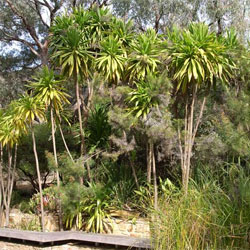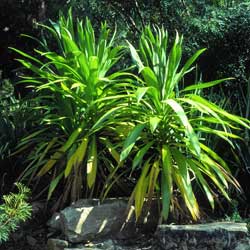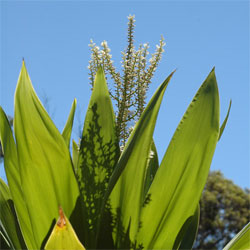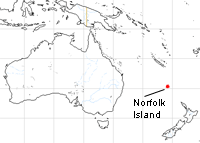Cordyline obtecta
 |
 |
 |
Norfolk Island Cordyline
Cordyline obtecta (Graham) Baker (1875)
Cordylines can be described as a tree lily, having strap like leaves growing from a woody perennial stem with lily like flowers. The genus Cordyline is currently included in the family Asparagaceae, but has also been placed by others in a range of families including Agavaceae, Draceaneaceae and Lomandraceae.
The genus consists of approximately nineteen species distributed in Southeast Asia, Australia, New Zealand, Norfolk Island, Mauritius and the Reunion Islands; and South America. There are approximately eight Australian species with the majority occurring in Queensland. The most widespread and common tropical species is Cordyline petiolaris, growing in rainforest and wet eucalypt forest from south eastern Queensland to north eastern NSW. There are approximately six New Zealand species including Cordyline australis, a species that grows to a commonly reported height of fifteen metres.
 Cordyline obtecta is endemic to Norfolk Island and was first described by Graham in 1827. It is an occasionally multi-stemmed tree-like species with heads of numerous cascading broad sword-like leaves. Cordyline obtecta is considered by Lange et al. (2005) to be related to C. kaspar, a New Zealand species growing on Three Kings Island. Both C. obtecta and C. kaspar have leaves with relatively wide blades, a feature characteristic of most Australian species; whereas Cordyline australis has narrow fibrous leaves.
Cordyline obtecta is endemic to Norfolk Island and was first described by Graham in 1827. It is an occasionally multi-stemmed tree-like species with heads of numerous cascading broad sword-like leaves. Cordyline obtecta is considered by Lange et al. (2005) to be related to C. kaspar, a New Zealand species growing on Three Kings Island. Both C. obtecta and C. kaspar have leaves with relatively wide blades, a feature characteristic of most Australian species; whereas Cordyline australis has narrow fibrous leaves.
On Norfolk Island there are believed to be only 818 mature individuals and thus the species has been listed as vulnerable under the Environment Protection and Biodiversity Conservation Act 1999 (Cth).
Cordyline obtecta can be used as a feature tree because it can grow to 10m tall with a 20-30m trunk diameter when mature. The arching and cascading nature of the leaves add to its attractiveness. Flowering can occur in early spring and autumn, with white flowers borne on branches forming a pyramidal shape on the top of the stem. Currently there are no cultivars of this plant sold in Australia. In New Zealand there are cultivars sold but the exact parent plant is unknown, although it is claimed to be Cordyline obtecta. The plant can be readily cultivated from seed, requiring no special seed preparation or special seed growing mix.
Cordyline obtecta requires a warm slightly shaded location with no special soil requirements. While it is often said that it cannot withstand frost, plants have been growing outdoors in the Australian National Botanic Gardens for many years. No pruning of the leaves is required, although dead leaves may require periodic sweeping up from around the base. Mature plants can be readily transplanted, but care must be taken not to damage the bark or wound the stem. The damaged stem may fork from the wound or the inner wood could rot. Cordyline species are generally resistant to most pests and diseases but may be afflicted by scale insects or fungi if stressed.
Text by Bok-mun Ho (Botanical Intern 2006)
Derivation of name: Cordyline obtectaCordyline - derived from the Greek word kordyle, meaning club and refers to the enlarged underground stem or rhizome obtecta- relates to the Latin word obtegere, meaning to conceal or cover up, alluding to the flowers that scarcely protruded beyond the leaves of the first plant described |
References:
Wilson, A. (ed.) 1994, Flora of Australia: Oceanic Islands, Volume 49, Australian Government Publishing Service, Canberra
George, A.S (ed.) 1996, Flora of Australia Volume 46: Iridaceae to Dioscoreaceae, Australian Government Publishing Service, Canberra
Lange, P.J. de; Gardner, R.O.; Sykes, W. R.; Crowcroft ,G.M.; Cameron, E.K.; Stalker, F.; Christian, M.L. & Braggins, J.E. 2005, ‘Vascular flora of Norfolk Island: some additions and taxonomic notes’, New Zealand Journal of Botany 43: 563-596
International Cordyline Society 2006. Available at http://www.cordyline.org [Accessed: 10 th February 2006]
Manaaki Whenua Landcare Research 2006, ‘Flora of New Zealand Series’. Available at http://floraseries.landcareresearch.co.nz/pages/index.aspx [Accessed 10 th February 2006]
Simpson, P. 2000, Dancing leaves: the story of New Zealand’s cabbage tree, tī Kōuka, Canterbury University Press
Species Profile and Threats Database, Department of the Environment and Heritage. Available at http://www.deh.gov.au/cgi-bin/sprat/public/sprat.pl [Accessed 10 th February 2005]
![An Australian Government Initiative [logo]](/images/austgovt_brown_90px.gif)

